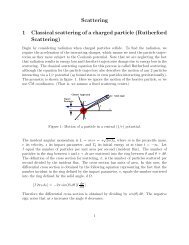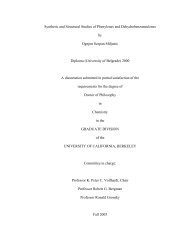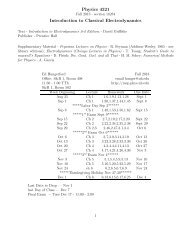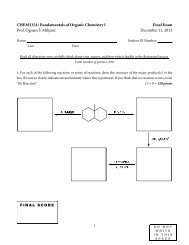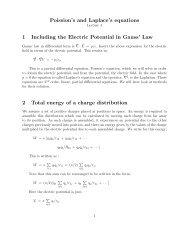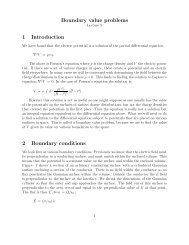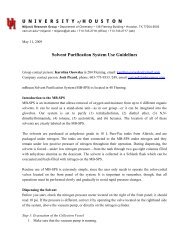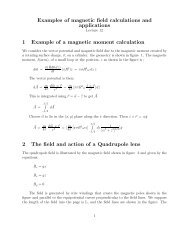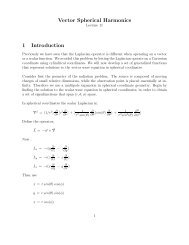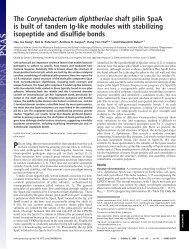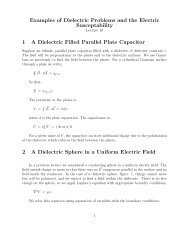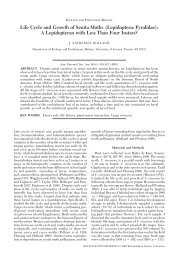(Orthoptera: Tettigoniidae) Species Composition and Size Across ...
(Orthoptera: Tettigoniidae) Species Composition and Size Across ...
(Orthoptera: Tettigoniidae) Species Composition and Size Across ...
You also want an ePaper? Increase the reach of your titles
YUMPU automatically turns print PDFs into web optimized ePapers that Google loves.
336 Estuaries <strong>and</strong> Coasts: J CERF (2008) 31:335–343tettigoniid grasshoppers. Herbivore pressure on salt marshplants appears to be stronger at lower latitudes (Pennings <strong>and</strong>Silliman 2005; Pennings unpublished data). This increasedherbivore pressure may cause plants at low latitudes todevelop stronger defenses against consumers (Siska et al.2002), resulting in decreased palatability of plants withdecreasing latitude (Pennings et al. 2001). It is likely thatlatitudinal variation in herbivore pressure is driven, at least inpart, by geographic variation in grasshopper species composition(Pennings <strong>and</strong> Silliman 2005), but rigorous data toaddress this hypothesis are lacking.Few data on grasshopper species composition exist forAtlantic Coast salt marshes, except for one study inNorth Carolina (Davis <strong>and</strong> Gray 1966). Although nocomparative studies have been conducted across broadgeographic regions, ecological studies in New Engl<strong>and</strong>(Bertness et al. 1987; Bertness <strong>and</strong> Shumway 1992),Georgia (Smalley 1960), <strong>and</strong> Mississippi (Parsons <strong>and</strong> dela Cruz 1980) have focused on different tettigoniidgrasshopper species (Conocephalus spartinae in NewEngl<strong>and</strong>, Orchelimum fidicinium in Georgia, <strong>and</strong> O.concinnum in Mississippi), which presumably were themost abundant grasshoppers at each site. Whether thisreflects local site-to-site variation in species compositionor a broader geographic pattern, however, is unclear.Nevertheless, based on these studies, the feeding ecologyof different tettigoniid species appears to vary, with C.spartinae feeding primarily on flowers <strong>and</strong> seeds (Bertnesset al. 1987; Bertness <strong>and</strong> Shumway 1992) <strong>and</strong>Orchelimumspp. feeding on leaves (Smalley 1960; Parson <strong>and</strong> de la Cruz1980). This suggests that documenting patterns of grasshopperspecies composition across latitude would improve ourunderst<strong>and</strong>ing of biogeographic patterns in plant–insectinteractions.One obstacle to addressing these issues has been thedifficulty in identifying tettigoniid grasshoppers to species.Although tettigoniids have been the subject of excellenttaxonomic monographs (Rehn <strong>and</strong> Hebard 1915a, b, c), thespecies are morphologically quite similar <strong>and</strong> difficult for nonexpertsto identify to species. Therefore, in addition todocumenting tettigoniid species composition <strong>and</strong> distributionin salt marshes along the Atlantic Coast of the USA, weprovide a resource to facilitate tettigoniid species identificationby future workers.Materials <strong>and</strong> MethodsStudy Sites <strong>and</strong> CollectionsWe collected tettigoniid grasshoppers from the Spartinaalterniflora zone of 31 salt marsh sites along the AtlanticCoast of the USA from Florida to Maine across a latitudinalrange of 13.19° (Table 1). Our sampling focused on theS. alterniflora zone because this is the largest vegetationzone in many Atlantic Coast salt marshes <strong>and</strong> occurs at alllatitudes. We collected an average of 24 (range 1 to 59)adult tettigoniids from each site, for a total of 740individuals. We visited most sites once or twice in thesummer of each of 3 years (2004–2006). In addition, wemade a few collections (N=99 of the 740) in May,September, <strong>and</strong> October to confirm that species compositiondid not vary seasonally (it did not), <strong>and</strong> a small number(N=24 of the 740) of specimens were collected in Octoberof 2003. Collecting methods were consistent across sites,although the time spent collecting was greater at sites wheregrasshopper density was low. Because our interest was inthe relative abundance of different grasshopper species, wedid not document absolute densities (numbers per squaremeter). We collected only adult tettigoniids, avoidingjuvenile tettigoniids, which were difficult to identify tospecies, as well as individuals from other grasshopperfamilies (i.e., Acrididae), which were rare in the S.alterniflora zone. We collected tettigoniids using a combinationof sweep netting, targeted netting, <strong>and</strong> h<strong>and</strong>collection. In addition, we collected tettigoniids (N=52)from the Juncus roemerianus zone of four low-latitude saltmarsh sites for comparative purposes (three sites in GA <strong>and</strong>one in SC) on one date per site in either 2005 or 2006. TheJuncus zones at these sites were dominated by J.roemerianus, with small amounts of Batis maritima,Borrichia frutescens, Distichlis spicata, orS. alterniflora.Identification of Tettigoniid <strong>Species</strong>We classified tettigoniids to species following Rehn <strong>and</strong>Hebard (1915a, b, c) <strong>and</strong> by comparing our specimens tothose in the collection of the Entomology <strong>and</strong> NematologyDepartment, University of Florida, Gainesville. The eighttettigoniid species that we found in Atlantic Coast S.alterniflora salt marshes can be distinguished based onbody size, wing length, coloration, <strong>and</strong> morphology ofgenitalia (cerci in males <strong>and</strong> ovipositors in females).Tettigoniids were observed under a dissecting microscope<strong>and</strong> measured with electronic calipers (Fig. 1). Body sizewas measured as the length of the grasshopper, excludingthe cerci or ovipositor, from the tip of the head to the end ofthe abdomen. Measurements of body size, however, areaffected by the posture of the preserved grasshopper. Amore reliable indicator of size is the length of the hind tibia,which was measured from the joint between the tibia <strong>and</strong>femur to the joint between the tibia <strong>and</strong> tarsus. We focusedon tibia length for our analyses, but analyses of body lengthproduced similar results. Wing length was measured fromthe abuttal of the pronotum <strong>and</strong> wing to the distal end of thewing. Each cercus was measured from the abuttal with the
Estuaries <strong>and</strong> Coasts: J CERF (2008) 31:335–343 339Fig. 3 Male cerci (top) <strong>and</strong>female ovipositors (bottom) inseven tettigoniid species. OF, O.fidicinium; OC, O. concinnum;CS, C. spartinae; CA, C. aigialus;CF, C. fasciatus; CH, C.hygrophilus; CN, C. nigropleuroides.Photographs are not to thesame exact scale. Scale barsrepresent 1 mm. Range of cercuslengths (mm): OF, 1.40–3.28;CS, 1.00–2.06; CA, 1.70; CF,1.17–1.53; CH, 1.20–2.20; CN,1.60–2.20. Range of ovipositorlengths (mm): OF, 9.10–15.06;OC, 8.20; CS, 7.00–11.94; CF,6.28–7.92; CH, 10.56–15.77;CN, 13.90–16.80. Color photographsof the reproductive anatomyfor these species can befound at the following URL:anatomical features (Rehn <strong>and</strong> Hebard 1915b, c), especiallyif specimens have been preserved in alcohol. O. fidiciniumis green or brown. The distinguishing feature of O.concinnum is its vertical facial stripe. Its body is variegated,with areas of green, yellow, purple, <strong>and</strong> brown. C. fasciatusis green, with a black stripe from its fastigium to the end ofits abdomen. C. spartinae is green with an orangeabdomen, while C. hygrophilus can be either uniformlygreen or dark brown on its head <strong>and</strong> sides, light brown onits back <strong>and</strong> legs, <strong>and</strong> dark orange on its abdomen. C.nigropleuroides has a strikingly unique coloration, with ablack head, orange abdomen, <strong>and</strong> green legs. It is importantto note the color of C. nigropleuroides when it is alivebecause it can be difficult to distinguish from otherConocephalus species based on anatomy alone. C. aigialusis superficially similar to C. spartinae (green with anorange abdomen), but in contrast to the linear color patternson the femora of the other tettigoniids, femora of thisspecies are green, with mottled orange. N. melanorhinus islight green <strong>and</strong> is distinguished by black coloration of halfor all of the ventral surface of the cone at the tip of its head(Rehn <strong>and</strong> Hebard 1915a).Cercus Morphology The cerci of Orchelimum spp. areeasily distinguishable from those of Conocephalus spp.(Fig. 3). Orchelimum spp. cerci are about 50% larger <strong>and</strong>pointed at their distal ends compared to Conocephalus spp.cerci, which are smaller <strong>and</strong> relatively blunt at their distalends (Rehn <strong>and</strong> Hebard 1915b, c).The cerci of O. fidicinium are long, <strong>and</strong> each comes to anarrow point at the distal end, with an upward curvingtooth. The cerci of O. concinnum are slightly shorter thanthose of O. fidicinium; each cercus is comparatively blunt atthe distal end with a tooth that extends perpendicularly. Thecerci of C. fasciatus are short relative to other Conocephalusspecies, <strong>and</strong> each cercus has a tooth that extends perpendicularlywith a unique blackened tip. Each cercus of C.spartinae has an extended medial swelling in the shape of arectangle. The distal end often diverges from the medialswelling at an angle extending laterally. The cerci of C.nigropleuroides are very similar to those of C. spartinae.Rehn <strong>and</strong> Hebard (1915c) state that the cerci of C. spartinaeare slightly shorter, with smooth outlines, whereas the cerciof C. nigropleuroides are longer with irregular outlines, butwe found these details difficult to consistently observe. Thecercus of C. hygrophilus is streamlined from the distal end tothe portion proximal to the abdomen until disruption by abulbous swelling, which can partially obscure the tooth whenviewed from above. The cercus of C. aigialus is shaped likean inverted triangle, coming to a tapered <strong>and</strong> flattened pointat the distal end, with a large bulbous swelling near the tooth.Ovipositor Morphology Rehn <strong>and</strong> Hebard (1915b, c) statethat ovipositor morphology is not helpful in identifyingspecies because many species have similar ovipositors thatdisplay considerable intraspecific variation. As a last resort,female tettigoniids can be classified by association with malesfound at the same site (T. J. Walker, personal communication).
340 Estuaries <strong>and</strong> Coasts: J CERF (2008) 31:335–343Given the limited number of species found in Atlantic Coastsalt marshes, however, ovipositor length <strong>and</strong> shape are helpfulin distinguishing among some species (Fig. 3), especially ifused in combination with other characters.The ovipositor of O. fidicinium is relatively long with aweak upward sigmoidal curve (Rehn <strong>and</strong> Hebard 1915b).The ovipositor of O. concinnum is relatively short with arobust upward curve. The ovipositor of C. fasciatus showsthe beginnings of a weak sigmoidal curve at its base,proximal to the abdomen, but thereafter is straight. Theovipositor of C. spartinae is relatively short, with a slightupward curve. The ovipositor of C. nigropleuroides isextremely long <strong>and</strong> straight. The ovipositor of C. hygrophilusis similar to that of C. nigropleuroides, but tends tobe shorter than the body, whereas the ovipositor of C.nigropleuroides tends to be longer than the body. Theovipositor of C. aigialus is long <strong>and</strong> straight, with a smallbut distinct hump at the proximal end.Variation in Tettigoniid <strong>Species</strong> <strong>Composition</strong>O. fidicinium <strong>and</strong> C. spartinae dominated the tettigoniidfauna of the S. alterniflora zone of Atlantic Coast saltmarshes, comprising 89% of the total individuals collected(57 <strong>and</strong> 32% of the total, respectively; see Fig. 4). Inaddition, O. concinnum <strong>and</strong> C. fasciatus could be locallyProportion of collected tettigoniids (%)10080604020030.0130.431.2331.2731.2831.331.3232.3233.1933.2133.2233.5734.0837.1737.2337.2638.0239.0539.3341.2141.3441.3741.4542.4242.4443.0243.1943.2Latitude (degrees)Orchelimum fidiciniumNeoconocephalus melanorhinusConocephalus spartinaeConocephalus aigialusConocephalus fasciatusConocephalus hygrophilusConocephalus nigropleuroidesFig. 4 Relative abundance of adults of eight tettigoniid speciescollected from the S. alterniflora zone at 31 sites along a latitudinalgradient. Sample size ranged from 15 to 59 individuals per site(average 26 individuals per site; three sites with sample sizes of fewerthan ten individuals were omitted from this figure)abundant, comprising more than 50% of the individuals atone <strong>and</strong> three sites, respectively. The four remaining specieswere never abundant at any site.Orchelimum spp. <strong>and</strong> Conocephalus spp. showed astriking pattern of latitudinal turnover in relative abundance(Fig. 4). Orchelimum species, mostly O. fidicinium,dominated the S. alterniflora zone of low-latitude saltmarshes, while Conocephalus species, mostly C. spartinae,dominated in high-latitude marshes. A precipitous switch inthe relative abundances of these taxa occurred at about 37°of latitude.Comparative sampling in the J. roemerianus zone at fourlow-latitude sites (between 31.23 <strong>and</strong> 33.21° of latitude, fromGA to SC; see Table 1) yielded only O. concinnum (N=29),C. spartinae (N=15), C. aigialus (N=7), <strong>and</strong> C. nigropleuroides(N=1). O. concinnum was most abundant overall,although C. aigialus <strong>and</strong> C. spartinae were locally abundantat particular sites (data not shown). Although a fewindividuals of O. fidicinium <strong>and</strong> N. melanorhinus werevisually observed in the Juncus zone of low-latitude marshes,both were absent from these collections, as were C. fasciatus<strong>and</strong> C. hygrophilus.Tettigoniid Feeding PreferencesO. fidicinium consumed large amounts of S. alterniflora[635.6±93.3 (SE) mm 2 ], but O. concinnum, C. spartinae,C. aigialus, <strong>and</strong> C. nigropleuroides almost completelyignored this plant (maximum consumption of 1.4±1.1 mm 2 ; F 4,60 =79.0, P
Estuaries <strong>and</strong> Coasts: J CERF (2008) 31:335–343 341Tibia length (mm)201816141210828 30 32 34 36 38 40 42 44Orchelimum fidicinium femalesOrchelimum fidicinium malesLatitude (degrees)Conocephalus spartinae femalesConocephalus spartinae malesFig. 5 Body size (tibia length) of adult O. fidicinium <strong>and</strong> C. spartinaemales <strong>and</strong> females as a function of latitude. For O. fidicinium, N=20sites (total of 196 females <strong>and</strong> 176 males nested within sites); for C.spartinae, N=18 sites (total of 109 females <strong>and</strong> 103 males nestedwithin sites). For both species, body size differed among sexes <strong>and</strong>across latitude (ANCOVA, P
342 Estuaries <strong>and</strong> Coasts: J CERF (2008) 31:335–343sizes. In contrast, Conocephalus species are about 50%smaller than O. fidicinium at the same latitude, <strong>and</strong> so maybe able to prosper at high latitudes despite selectivepressures for small size.Fourth, <strong>and</strong> finally, reduced zonation of vegetation innorthern marshes could also contribute to the observedspecies turnover. Plants in salt marshes are arranged inmore or less monospecific zones across an elevationalgradient (Chapman 1975). At high latitudes on the AtlanticCoast of the USA, salt marshes are relatively small, <strong>and</strong>plant zones are therefore highly compressed (Teal 1986). Incontrast, low-latitude marshes are more expansive, <strong>and</strong>vegetation zones are broader (Wiegert <strong>and</strong> Freeman 1990).If Conocephalus species prefer other vegetation zones morethan the S. alterniflora zone (see below), they would bemore likely to w<strong>and</strong>er into the S. alterniflora zone astransients at high latitudes, where the vegetation zones arecompressed, than at low latitudes where the vegetationzones are expansive.Whatever the reason for the variation in speciescomposition across latitude, this variation likely hasimplications for marsh trophic ecology. As Conocephalusspecies mostly eat seeds <strong>and</strong> insect prey, whereas O.fidicinium feeds readily on leaves of S. alterniflora, thedifferent feeding preferences of these different tettigoniidspecies may contribute to a gradient in consumer pressurealong the Atlantic Coast, with greater herbivore pressure atlower latitudes (Pennings <strong>and</strong> Silliman 2005). If so, thiscould help select for the lower palatability of S. alternifloraleaves at low vs high latitudes (Pennings et al. 2001).Although tettigoniid collections from the J. roemerianuszone consisted of relatively few individuals, they weredistinctive enough to help explain some of the patternsobserved in the more extensive collections from the S.alterniflora zone. The data suggest that components of thediet of C. spartinae can be found in both zones. Otherspecies were more specialized in their habitat use. O.fidicinium appears to be limited to the S. alterniflora zone.Given that O. concinnum was found much more frequentlyin the Juncus than the Spartina zone, it appears to be aspecialist herbivore on J. roemerianus (Parsons <strong>and</strong> de laCruz 1980), along with C. aigialus. These two tettigoniidspecies appear to be transient visitors to the S. alterniflorazone. It is possible that differences in feeding preferencesamong tettigoniid species are reinforced by competition orintraguild predation (Wason, unpublished data), but experimentaltests of these possibilities are lacking. The remainingfour species were not collected often enough to makedefinitive statements about their habitat use. Further studiesshould examine the tettigoniid composition of high-elevationmarsh zones, dominated by J. roemerianus at low latitudes<strong>and</strong> J. gerardii <strong>and</strong> S. patens at high latitudes, to moredefinitively determine the geographic distributions of speciesthat are not common in the S. alterniflora zone or that usemultiple vegetation zones.It has long been anecdotally noted that many species oftettigoniids decrease in size with increasing latitude (Rehn<strong>and</strong> Hebard 1915a, b, c), in agreement with the “Converseto Bergmann’s Rule” (Masaki 1967, 1978; Masaki <strong>and</strong>Walker 1987; Mousseau 1997). Our results provide quantitativedata to rigorously support these observations for O.fidicinium <strong>and</strong> C. spartinae (Fig. 5). We also documentedthat females of these species are larger than males, whichappears to be a general pattern in tettigoniids (Rehn <strong>and</strong>Hebard 1915a, b, c) <strong>and</strong> many other insect species, likelybecause female egg production is limited by body size.The generality <strong>and</strong> causes of latitudinal variation in bodysize are widely debated in the literature (Partridge <strong>and</strong>Coyne 1997; Van Voorhies 1997; Walters <strong>and</strong> Hassall2006) <strong>and</strong> are outside the scope of this paper. Our interesthere is in relating these body size patterns to latitudinalturnover in species composition <strong>and</strong> latitudinal variation inherbivore pressure. First, as we noted above, selection forsmall body sizes at high latitudes may contribute to theturnover in species composition from the large-bodied O.fidicinium at low latitudes to the small-bodied C. spartinaeat high latitudes. Second, because as a general rule feedingrates increase with body size (Peters 1983), larger tettigoniidbody size at low latitudes is likely to lead to greaterherbivore pressure even if herbivore species <strong>and</strong> density areconstant. Data suggest, however, that grasshoppers occur inhigher abundance at low latitudes (Pennings, unpublisheddata). Thus, latitudinal variation in herbivore body size maycontribute to observed gradients in herbivore pressure(Pennings <strong>and</strong> Silliman 2005) <strong>and</strong> plant resistance toherbivores (Pennings et al. 2001) at low latitudes.In summary, we found striking differences in thetettigoniid community of the S. alterniflora zone at low<strong>and</strong> high latitudes. Low-latitude sites were dominated by O.fidicinium <strong>and</strong> high-latitude sites by C. spartinae. Six othertettigoniid species were present. At least two species werelikely transients from the J. roemerianus zone or otherhabitats, but others were occasionally locally abundant. Thetwo most common species increased in body size at lowlatitudes. Feeding preferences varied among tettigoniidspecies. Latitudinal variation in tettigoniid species composition<strong>and</strong> body size likely contributes to latitudinal patterns inmarsh community structure <strong>and</strong> plant palatability.Acknowledgments We thank Chuan-Kai Ho, Cara Gormally, <strong>and</strong>Cristiano Salgado for advice <strong>and</strong> assistance in the field; Laura Cammonfor library assistance; <strong>and</strong> Thomas J. Walker for making his grasshopperspecimen collection available <strong>and</strong> helping us identify grasshoppers. Wethank NSF (DEB-0296160), the GCE LTER program (OCE99-82133),the National Geographic Society (5902-97), <strong>and</strong> the Baruch Marine FieldLaboratory (Visiting Scientist Award to SCP) for funding. We thankDiane Wiernasz <strong>and</strong> Alfred Loeblich for constructive comments on a
Estuaries <strong>and</strong> Coasts: J CERF (2008) 31:335–343 343draft of this manuscript. ELW thanks the Honors College Office ofUndergraduate Research at the University of Houston for funding(Summer Undergraduate Research Fellowship), <strong>and</strong> Corazon Loteyrofor continuing support. This is contribution number 960 from theUniversity of Georgia Marine Institute.ReferencesBertness, M.D., <strong>and</strong> P.J. Ewanchuk. 2002. Latitudinal <strong>and</strong> climatedrivenvariation in the strength <strong>and</strong> nature of biological interactionsin New Engl<strong>and</strong> salt marshes. Oecologia 132: 392–401.Bertness, M.D., <strong>and</strong> S.W. Shumway. 1992. Consumer driven pollenlimitation of seed production in marsh grasses. American Journalof Botany 79: 288–293.Bertness, M.D., C. Wise, <strong>and</strong> A.M. Ellison. 1987. Consumer pressure<strong>and</strong> seed set in a salt marsh perennial plant community.Oecologia 71: 190–200.Chapman, V.J. 1975. The salinity problem in general, its importance,<strong>and</strong> distribution with species reference to natural halophytes. InPlants in saline environments, eds. A. Poljakoff-Mayber, <strong>and</strong>J. Gale, 7–24. New York: Springer.Craft, C. 2007. Freshwater input structures soil properties, verticalaccretion, <strong>and</strong> nutrient accumulation of Georgia <strong>and</strong> U.S. tidalmarshes. Limnology & Oceanography 52: 1220–1230.Davis, L.V., <strong>and</strong> I.E. Gray. 1966. Zonal <strong>and</strong> seasonal distribution ofinsects in North Carolina salt marshes. Ecological Monographs36: 275–295.Denno, R.F., G.K. Roderick, M.A. Peterson, A.F. Huberty, H.G.Dobel, M.D. Eubanks, J.E. Losey, <strong>and</strong> G.A. Langellotto. 1996.Habitat persistence underlies intraspecific variation in thedispersal strategies of planthoppers. Ecological Monographs 66:389–408.Masaki, S. 1967. Geographic variation <strong>and</strong> climatic adaptation in afield cricket (<strong>Orthoptera</strong>: Gryllidae). Evolution 21: 725–741.Masaki, S. 1978. Seasonal <strong>and</strong> latitudinal adaptations in the life cyclesof crickets. In Evolution of insect migration <strong>and</strong> diapause, ed. H.Dingle, 72–100. New York: Springer.Masaki, S., <strong>and</strong> T.J. Walker. 1987. Cricket life cycles. EvolutionaryBiology 21: 349–423.Mousseau, T.A. 1997. Ectotherms follow the converse to Bergmann’srule. Evolution 51: 630–632.Parsons, K.A., <strong>and</strong> A.A. de la Cruz. 1980. Energy flow <strong>and</strong> grazingbehavior of conocephaline grasshoppers in a Juncus roemerianusmarsh. Ecology 61: 1045–1050.Partridge, L., <strong>and</strong> J.A. Coyne. 1997. Bergmann’s rule in ectotherms: Isit adaptive. Evolution 51: 632–635.Pennings, S.C., <strong>and</strong> B.R. Silliman. 2005. Linking biogeography <strong>and</strong>community ecology: Latitudinal variation in plant–herbivoreinteraction strength. Ecology 86: 2310–2319.Pennings, S.C., <strong>and</strong> M.D. Bertness. 1999. Using latitudinalvariation to examine effects of climate on coastal salt marshpattern <strong>and</strong> process. Current Topics in Wetl<strong>and</strong> Biogeochemistry3: 100–111.Pennings, S.C., <strong>and</strong> M.D. Bertness. 2001. Salt marsh communities. InMarine community ecology, eds. M. D. Bertness, S. D. Gaines, <strong>and</strong>M. E. Hay, 289–316. Sunderl<strong>and</strong>, Massachusetts: Sinauer.Pennings, S.C., E.L. Siska, <strong>and</strong> M.D. Bertness. 2001. Latitudinaldifferences in plant palatability in Atlantic Coast salt marshes.Ecology 82: 1344–1359.Pennings, S.C., E.R. Selig, L.T. Houser, <strong>and</strong> M.D. Bertness. 2003.Geographic variation in positive <strong>and</strong> negative interactions amongsalt marsh plants. Ecology 84: 1527–1538.Peters, R.H. 1983. Cambridge studies in ecology: The ecologicalimplications of body size. Cambridge, UK: Cambridge UniversityPress.Rehn, J.A.G., <strong>and</strong> M. Hebard. 1915a. Studies in American <strong>Tettigoniidae</strong>(<strong>Orthoptera</strong>): III. A synopsis of the species of the genus Neoconocephalusfound in North America, north of Mexico. Transactionsof the American Entomological Society 40: 365–413.Rehn, J.A.G., <strong>and</strong> M. Hebard. 1915b. Studies in American <strong>Tettigoniidae</strong>(<strong>Orthoptera</strong>): IV. A synopsis of the species of the genusOrchelimum. Transactions of the American Entomological Society41: 11–83.Rehn, J.A.G., <strong>and</strong> M. Hebard. 1915c. Studies in American <strong>Tettigoniidae</strong>(<strong>Orthoptera</strong>): V. A synopsis of the species of the genusConocephalus found in North America, north of Mexico. Transactionsof the American Entomological Society 41: 155–224.Seliskar, D.M., J.L. Gallagher, D.M. Burdick, <strong>and</strong> L.A. Mutz. 2002.The regulation of ecosystem functions by ecotypic variation in adominant plant: A Spartina alterniflora salt-marsh case study.Journal of Ecology 90: 1–11.Siska, E.L., S.C. Pennings, T.L. Buck, <strong>and</strong> M.D. Hanisak. 2002.Latitudinal variation in palatability of salt-marsh plants: Whichtraits are responsible. Ecology 83: 3369–3381.Smalley, A.E. 1960. Energy flow of a salt marsh grasshopperpopulation. Ecology 41: 672–677.Teal, J.M. 1986. The ecology of regularly flooded salt marshes ofNew Engl<strong>and</strong>: A community profile. U.S. Fish <strong>and</strong> WildlifeService Biological Report 85(7.4).Turner, R.E. 1976. Geographic variations in salt marsh macrophyteproductions: A review. Contributions in Marine Science 20: 47–68.Van Voorhies, W.A. 1997. On the adaptive nature of Bergmann sizeclines: A reply to Mousseau, Partridge <strong>and</strong> Coyne. Evolution 51:635–640.Walker, T.J. 1964. Cryptic species among sound-producing Ensiferan<strong>Orthoptera</strong> (Gryllidae <strong>and</strong> <strong>Tettigoniidae</strong>). Quarterly Review ofBiology 39: 345–355.Walters, R.J., <strong>and</strong> M. Hassall. 2006. The temperature–size rule inectotherms: May a general explanation exist after all. AmericanNaturalist 167: 510–523.Wiegert, R.G., <strong>and</strong> B.J. Freeman. 1990. Tidal salt marshes of theSoutheast Atlantic Coast: A community profile. Washington, DC:US Department of the Interior, Fish <strong>and</strong> Wildlife Service.




